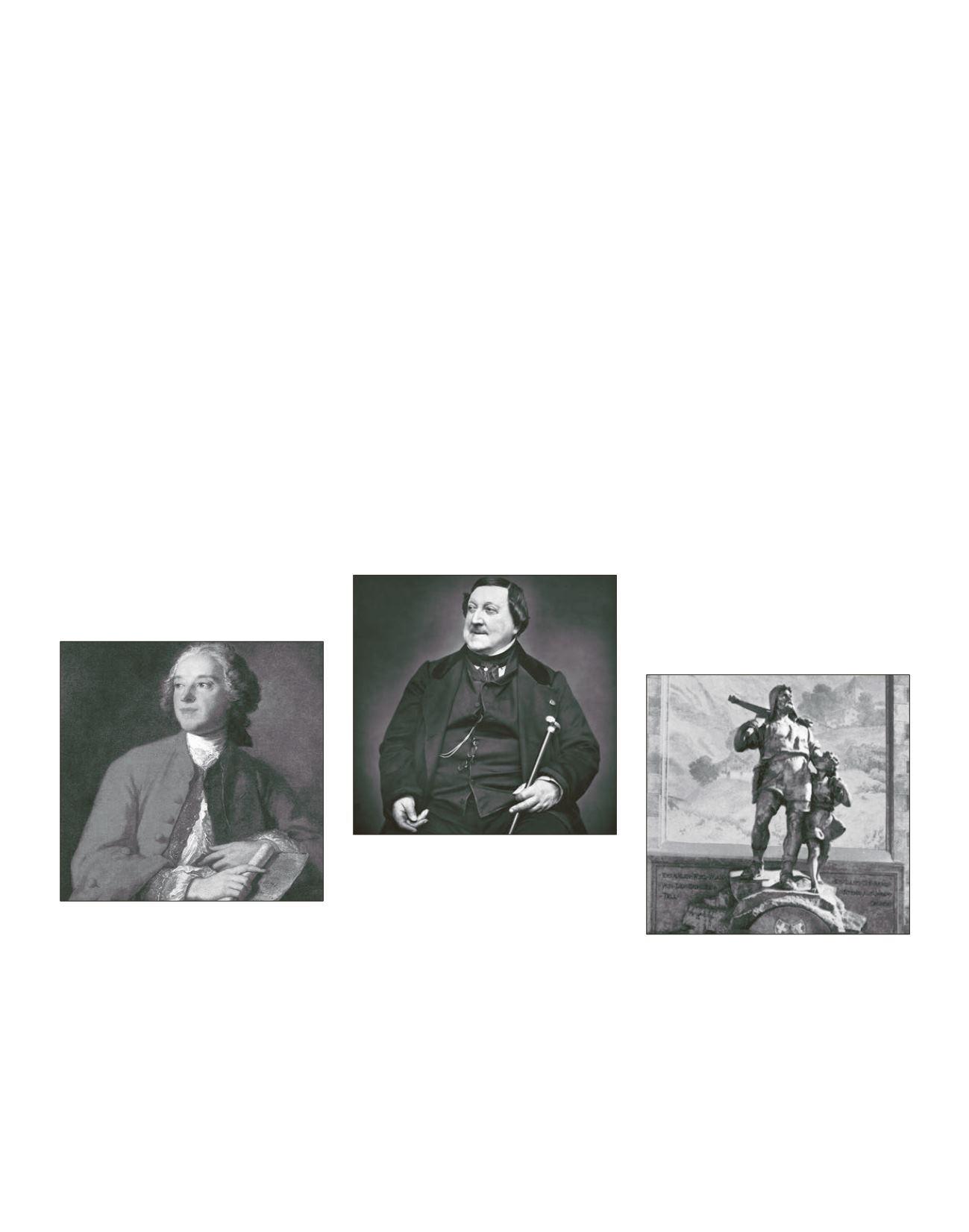
GIOACHINO ROSSINI (1792–1868)
Instrumental selections from the operas
Overture to
Il barbiere di Siviglia
(
e Barber of Seville
)
Scored for ute and piccolo, pairs of oboes, clarinets,
bassoon, horns and trumpets, three trombones,
timpani, bass drum, and strings
Rossini composed
Il barbiere di Siviglia
(
e
Barber of Seville
) in about three weeks in
;
contracts with the Teatro Argentino in Rome
were drawn on January , the rst act was n-
ished February , and Rossini’s full score was
completed by February .
Il barbiere di Siviglia
(originally titled
Almaviva, ossia L’inutile pre-
cauzione
, or
Almaviva, or
e Useless Precau-
tion
) was based on a libretto by Cesare Sterbi-
ni a er the semi-autobiographical comedy by
Beaumarchais that appeared in
, the rst of
his Figaro trilogy (with
Le mariage de Figaro
and
La mère coupable
). e story struggled for pub-
lic recognition in an earlier operatic setting by
Giovanni Paisiello. Within a generation, Paisiel-
lo dri ed into obscurity and Rossini became a
hero of the Italian public. None other than Verdi
said, “I confess that I cannot help believing
Il
barbiere di Siviglia
, for abundance of ideas, for
comic verve, and for truth of declamation, the
most beautiful
opera bu a
in existence.” Rossini
o ers immediate con rmation of his incredi-
ble “abundance” in the thematically varied and
imaginatively orchestrated overture.
e Sevillian Dr. Bartolo has guardianship of
Rosina, but he also would like to marry her be-
cause of her fortune. However, she is attracted to
the nobleman Count Almaviva, who is incognito
as Lindoro. e jack-of-all-trades Figaro bursts
onto the scene with an excited recitation of his
skills (barber, surgeon, wigmaker, and others),
which are in great demand around town (“Lar-
go al factotum”). He agrees to help the young
man and woman outwit the doctor. Inside Dr.
Bartolo’s house, Rosina holds a letter and sings
of her devotion to Lindoro. She describes her
better personality traits, but admits she can be-
come a viper if crossed (“Una voce poco fa”).
Later in this scene, Figaro informs Rosina that
his cousin Lindoro has fallen in love with her.
e love-struck man would surely come if she
would write him a short note. Rosina already
has dra ed a full letter and longingly awaits his
arrival; Figaro makes cynical remarks about her
wiliness (“Dunque io son”).
Overture to
Semiramide
Scored for ute and piccolo, two oboes, two clarinets,
two bassoons, four horns, two trumpets, three trom-
bones, timpani, bass drum, and strings
Rossini’s nal opera for Italy, the two-act
Semi-
ramide
, opened at the Teatro La Fenice in Ven-
ice on February ,
.
e drama
Sémiramis
( ) by French playwright, philosopher, and
poet Voltaire provided a model for the libretto
by Gaetano Rossi. (Ten years earlier, Rossini and
Rossi adapted another of Voltaire’s writings for
the opera
Tancredi
.) Following the triumphant
success of
Semiramide
, Rossini le Italy with his
wife Maria Malibran to conquer the operatic
stages of Paris.
e painter Eugène Delacroix re ected on a
performance of
Semiramide
he attended in
Paris: “What remains in my mind is the im-
pression of the sublime which abounds in that
work. Especially when I am away from the stage,
memory blends the various e ects into a single
whole. A few divine passages transport me back
to what I was in my youth. When Rossini rst
appeared, nobody noticed how romantic he was.
He breaks from the old formulas illustrated by
the classics in his time. Only in him does one
nd those introductions full of pathos and those
swi passages which, outside of all convention,
sum up a whole human situation.
is is the
only aspect of his talent that cannot be imitated.”
Evidence of Rossini’s marvelous invention may
be heard in the Overture to
Semiramide
, one of
the longest the composer ever wrote. Priests and
worshippers gather outside the Temple of Baal.
Semiramide, the Babylonian queen from the
th century , soon will arrive. e overture,
with its solemn introduction, captures both the
opulence of the ancient capital and the tragedy
to take place within its walls.
Overture and Pas de six from
Guillaume Tell
(
William Tell
)
Scored for two utes and piccolo, two oboes and En-
glish horn, two clarinets, two bassoons, four horns,
two trumpets, three trombones, timpani, triangle,
bass drum, cymbals, and strings
Italian composer Gioachino Rossini conclud-
ed his stellar opera career before the age of
with
Guillaume Tell
(
William Tell
), a
grand opéra
written for the Paris Opera. Rossini considered
several stories before settling on an adaptation
of Friedrich von Schiller’s play
Wilhelm Tell
.
Étienne de Jouy produced the four-act libret-
to, which was subsequently revised by Hip-
polyte-Louis-Florent Bis and others.
Guillaume
Tell
opened at the Paris Opera on August ,
.
is original version was approximately
four hours long. When Rossini returned to Paris
two years later, he created an abridged, three-act
version.
A band of Swiss patriots led by William Tell reb-
els against the despotic governor Gessler. One
young patriot, Arnold, falls in love with Gessler’s
daughter Mathilde. ey are secretly betrothed.
e captain of the guard arrests Tell and his son
Jemmy for not showing proper respect for the
bow and arrow. e rebel safely pierces the fruit
Pierre-Augustin Caron de Beaumarchais
Photograph of Gioachino Rossini by Étienne Carjat
(1865)
Monument of William Tell in Altdorf, Switzerland by
Richard Kissling (1895)
RAVINIA MAGAZINE | AUGUST 6 – AUGUST 12, 2018
114








